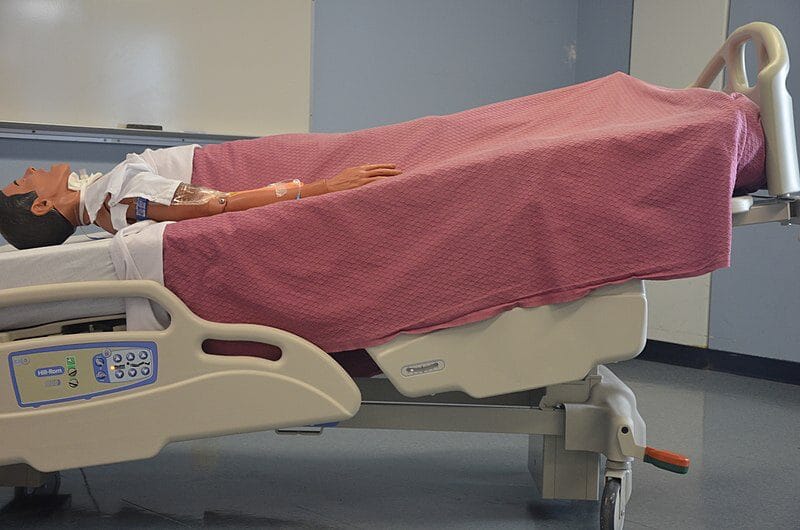Many fear that once an IV drip runs out, air from it can enter the circulatory system and cause a deadly air embolism. We decided to check whether this fear is justified.
Probable entering a vein air from ended drip worries many Internet users. Questions, what will happen in this case? patient And how much This dangerous, set to forums, V blogs and communities about medicine V social networks. This fear is also popularized by popular culture - for example, Ian McKellen’s character in the film “Able student“commits suicide by blowing into a catheter inserted into a vein. In the series "Dr. House"Dictator Dybala tries to provoke Dr. Allison Cameron into giving him an air bubble along with the injection. The mortal danger of air in a dropper or simply in a syringe is also played out in the TV series “Orange is the New Black" And "Monsters", and in the final "Eternity"The main character deals with his sworn enemy in this way (however, the air embolism does not kill him, but causes the syndrome locked man).
Air embolism is hit air bubbles into the bloodstream. Its prevalence is difficult to determine because mild cases are asymptomatic and patients do not seek medical help. Depending on where the air bubble ends up, venous, arterial and cerebral embolism are distinguished (also known as cerebral artery embolism). Venous is not as serious as arterial, which, in turn, is less dangerous than cerebral. For each of these varieties, the dangerous volumes of air differ. Thus, even 2–3 ml of air entering the cerebral arteries fatal dangerous, while fatal with venous embolism required at least 100–200 ml. The symptoms are also different: when the cerebral arteries are blocked, the formation of pathology occurs like an ischemic stroke, when the pulmonary artery is damaged, respiratory failure and pulmonary infarction develop, and when the artery supplying the organ is blocked, damage and possible necrosis of its tissues occur.
Often air embolism occurs due to a breakthrough in the walls of the alveoli with capillaries. In particular, this is a common complication among divers who do not follow safety precautions. She can also arise as a complication of chest injuries, with rupture of the placental veins during childbirth, during surgical interventions. Described even cases of air embolism in women during cunnilingus in the presence of damage and ruptures in the tissues of the vagina or uterus. Air can also enter the blood supply system due to an incorrectly selected mode of the artificial lung ventilation device (ventilator).
The pressure in the peripheral veins is normal (droppers are installed in them) doesn't allow air from outside gets inside. This is easy to verify if you remember the process of taking blood from a vein - when a needle is inserted, the blood begins to flow out, rather than air being sucked into the circulatory system. Therefore, even if the IV runs out, the air from it will not enter the body; on the contrary, a small amount of blood can rise through the catheter.
However, in the jugular or subclavian vein, the pressure can drop catastrophically due to dehydration and even become negative. However, in such conditions, the peripheral veins are “deflated” and it is impossible to install an IV. Moreover, to help a patient with severe dehydration, it is necessary to introduce so much fluid into the body that doing it through an IV is ineffective. In such cases, a central venous catheter is usually installed. During the procedure, doctors and their assistants carefully ensure that air does not enter the vein; according to the “gold standard,” they are recommended to perform ultrasound-guided catheterization. To prevent air embolism, the patient must first place in the Trendelenburg position (in which the pelvis is located above the head) - thus, the catheter installation site is lower than the heart and thereby the risk of air bubbles entering the bloodstream is minimized. Also recommended do not install a CVC while the patient is inhaling, so that the pressure in the central veins is maximum, but, on the contrary, should be removed during exhalation or during the Valsalva maneuver*.

However, it is impossible to completely exclude the possibility that during this procedure air will enter the circulatory system. For example, a cardiologist at the St. Petersburg Research Institute of Emergency Medicine named after. Dzhanelidze Konstantin Krulev describes such a case:
Many years ago, a patient was brought to my intensive care unit with a diagnosis of stroke. He was dehydrated - more than a day had passed since the stroke, and all this time he could not drink because he was unconscious. To place his central venous catheter, I inserted a needle into the subclavian vein and disconnected the syringe to insert a guidewire into the needle. At this time, a whistling sound was heard - air began to flow into the vein through the needle. Of course, I quickly clamped the needle gap with my finger, but some air still entered the circulatory system. Although I knew that it was relatively safe, I felt uneasy. True, in the end everything ended well - against the background of replenishing the volume of fluid, the patient felt much better, and he even regained consciousness.
Despite all precautions, air embolism is a common complication in surgery. During neurosurgical interventions, for example, it is happening in almost 80% of cases, and when orthopedic - in 57%. Even cases of air embolism have been described during ophthalmological operations - removal of a foreign body and correction of retinal detachment.
Experts from Johns Hopkins University (USA) analyzed more than 4000 reports of air embolism occurring during surgical procedures and categorized procedures into high, moderate and low risk. The first group included seven surgeries: sitting craniotomy (a type of brain surgery that involves removing part of the skull to gain access to the brain), posterior fossa or neck surgery, laparoscopic procedures, hip replacement, cesarean section, insertion and removal of a CVC, and correction of craniosynostosis, an early fusion of cranial sutures. Neither the moderate nor the low risk group includes procedures involving the placement of IVs into peripheral veins.
Thus, usually the pressure in the peripheral veins, where the IV is installed, does not allow air to enter the circulatory system. When dehydrated, venous pressure can drop critically; however, in such a state, it is almost impossible and ineffective to administer a regular IV to a patient. Instead, the patient is placed with a central venous catheter, with this procedure the risk of air embolism is much higher. However, it can be significantly reduced thanks to the correct technique and additional precautions such as ultrasound control.
*An exercise that involves trying to exhale forcefully with your mouth and nose pinched and your vocal cords closed. It is used, for example, by air passengers to get rid of the feeling of stuffiness in the ears during climb or loss of altitude, as well as turbulence.
Cover image: University of Providence
If you find a spelling or grammatical error, please let us know by highlighting the error text and clicking Ctrl+Enter.






